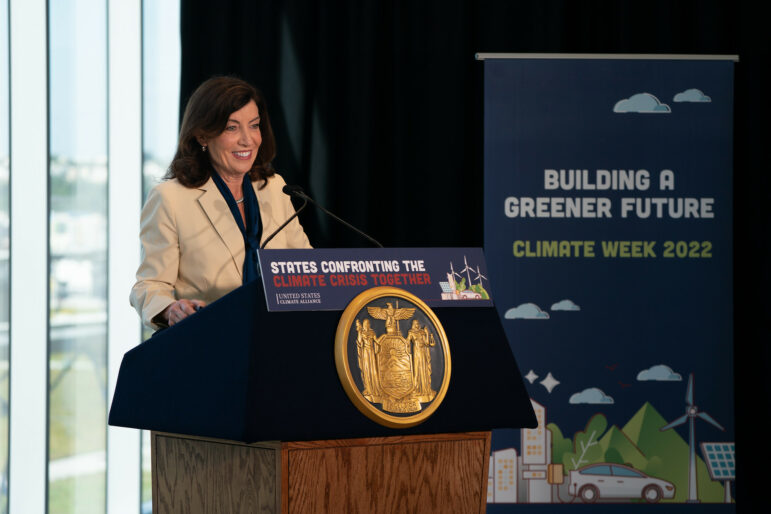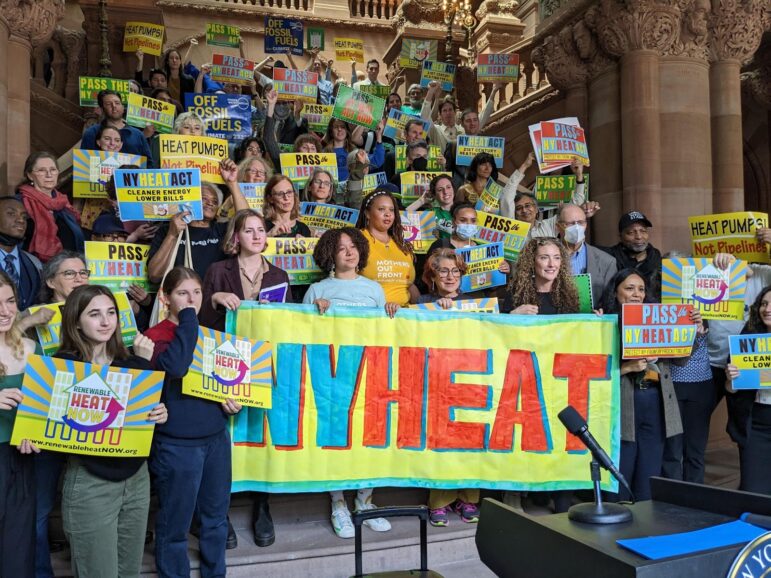Government officials estimate it will cost nearly $44 billion to fulfill the state’s climate law, which aims to stop powering the state with polluting fossil fuels and reduce 85 percent of greenhouse gas emissions below 1990 levels by 2050.

Flickr/ Governor Kathy Hochul
Gov. Kathy Hochul at a climate-related announcement in 2022.As the 2024 legislative session kicks off in Albany, environmental advocates say the priority this year will be to back legislation that shifts the burden of funding New York’s transition to a low-carbon economy away from the taxpayer—and make polluters pay instead.
Government officials estimate it will cost nearly $44 billion to fulfill the state’s climate law, which aims to stop powering the state with polluting fossil fuels and reduce 85 percent of greenhouse gas emissions below 1990 levels by 2050.
“We’re going to need real investment from the State to make sure [those costs are] not going to be on the backs of poor and working class New Yorkers. So we just have to make that happen,” said Alex Beauchamp, northeast region director at the non-profit Food & Water Watch.
To ensure New Yorkers aren’t footing the bill, environmental advocates say they will prioritize passage of the NY Heat Act, which would stop utility companies from using customer money to pay for new gas hookups. They’re also championing the Climate Change Superfund bill that would require the most prolific oil and gas producers to fund projects that protect the state from the effects of global warming.
They also plan to push Gov. Kathy Hochul to solidify details for an on-going Cap-and-Invest program, which will charge companies for carbon pollution and funnel the proceeds towards climate change mitigation efforts. The idea is to keep taxpayers from footing the entire bill for the massive expenses generated by the impacts of increasingly extreme weather.
Gov. Hochul’s opening statements ahead of this year’s legislative session signaled that making New York more affordable will be a top priority this year.
“If the last two years have been about putting more money in New Yorkers’ pockets, this year is about keeping it there and that starts with safeguarding people’s hard-earned cash,” the governor said in a press release announcing several consumer protection policies last week.
For the environmental community, Cap-and-Invest and bills like the NY Heat Act will allow Hochul to do just that.
“[These innitatives] allow us to fight the climate crisis and deal with the growing affordability crisis across the board in New York,” Beauchamp said.
‘The biggest thing on the table in Albany’
Senator Liz Krueger, who is sponsoring both the NY Heat Act and the Climate Change Superfund, is confident that her bills are a win-win for the state.
“I think a dual theme of both of those bills is that not only are they good for the planet, they save us money,” said Krueger.
The NY Heat Act puts a cap on utility bills so that low-and middle-income New Yorkers spend no more than 6 percent of their household income on utilities. This would save the average family $75 per month, according to Krueger.
The legislation also aims to nix regulations that make it easier for fossil fuel companies to use customer money to pay for gas line extensions.

Alliance for a Green Economy
Environmental advocates at a rally for passage of the NY Heat Act in the spring of 2023.As it stands, utility companies are required by law to supply gas without charge to any customer who wants it and lives within 100 feet of an existing line. But these hookups aren’t actually free: those costs are built into the rates utilities charge paying customers, costing New Yorkers up to $200 million annually. By getting rid of the 100 foot rule, the bill attempts to save ratepayers money.
Fossil fuel industry groups however are skeptical of the bill, saying that forcing homeowners to shift too quickly to electricity produced from renewable sources that are still scarce on the market will be very risky. Just 27 to 29 percent of the state’s electricity currently comes from renewable energy.
But environmentalists like Beauchamp, who called the NY Heat Act “the biggest thing on the table in Albany this year,” are prepared to fight for it.
Hochul’s office did not respond to City Limits’ request for comment on the governor’s climate plans this session.
‘How all this money is going to be spent’
Other advocates say that fleshing out the Cap-and-Invest program this year will be just as important.
Passed into law three years ago, the program establishes a cap on how much companies can pollute, and those that exceed those carbon emissions limits will have to purchase a permit to keep operating above that threshold. The cap, expected to go into effect in 2025, will get stricter over time until New York’s emissions are brought down by at least 85 percent by 2050, in accordance with the state’s climate law.
“The urgency of [Cap-and-Invest] never goes away. But I think the agencies are on track to finalize a rule this calendar year, and we will certainly be encouraging them to stick with that timeline,” said Kate Courtin, senior manager at the Environmental Defense Fund.
The state published a “pre-proposal” for the program in December, but a more solid draft will continue to evolve as interested parties weigh in and a final version of the proposal won’t be ready until end of this year. NYSERDA did not immediately respond to questions about its anticipated timeline.
One of the major aspects of Cap-and-Invest that advocates hope to see outlined in the governor’s budget this year are details on what will happen to money generated from the program.
“We can’t have the governor or the legislature prescribing how all this money is going to be spent,” Senator Peter Harckham, who chairs the State Senate’s environmental conservation committee, told City Limits.
“We need to create a flexible system where communities that have been impacted by climate change are able to make some of those decisions and then receive investments from the program. We need to focus on community centered investments,” he added.
Last year, Harckham sponsored a bill that would create a fund so that money earned from state programs like Cap-and-invest can be distributed for community efforts, like grassroots-led initiatives to reduce local emissions and job training programs for impacted workers. His bill didn’t pass, but mentions of the fund were included in Hochul’s final budget last year.

Michael Appleton/Mayoral Photography Office
Smoke from wide fires in Canada blurring the New York City skyline in June.‘The stakes are higher than ever’
Showing a willingness to move forward with these and other pillars of Cap-and-Invest, advocates say, will reinforce Hochul’s commitment to honoring the state’s 2019 Climate Leadership and Community Protection Act, or CLCPA.
“The stakes are higher than ever so the governor needs to be willing to step out and make sure that we fully implement the CLCPA,” said Raya Salter, a member of the New York State Climate Action Council and founder of the Energy Justice Law and Policy Center.
Setbacks in developing clean energy projects last year put into question the ability to meet the demands of the law, which requires that 70 percent of New York’s power come from renewable sources by 2030.
This year already started with the news that inflation and supply chain hurdles propelled the European energy firms Equinor and BP to terminate their contracts to sell clean energy to New York state from the offshore wind farm, Empire Wind 2.
To top it off, climate change related disasters have been mounting, creating a sense of urgency around finding a solution.
“This past summer we had the wildfires in Canada that lead to dangerous air quality in the state. On top of it all we had heat waves and unprecedented flooding,” said Liz Moran, a policy advocate at EarthJustice.
“So we think there’s a lot of pressure on the governor to address these issues, both in making sure we’re generating enough renewable energy to meet our climate law mandates and that we’re tackling the climate crisis to protect the wallets and the health of everyday New Yorkers,” she said.









One thought on “Environmentalists’ 2024 Albany Agenda? Making Polluters Pay”
I believe these proposals will help New York meet its climate goals and build a more sustainable future for everyone.